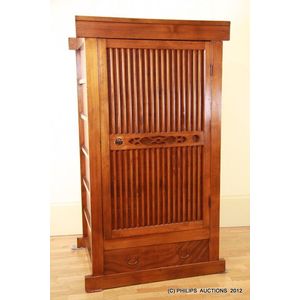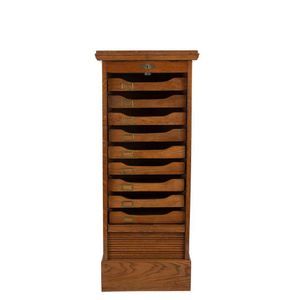Antique Oak Filing Cabinet with Tambour Front and Lectern Top
You must be a subscriber, and be logged in to view price and dealer details.
Subscribe Now to view actual auction price for this item
When you subscribe, you have the option of setting the currency in which to display prices to $Au, $US, $NZ or Stg.
- Circa - A Latin term meaning 'about', often used in the antique trade to give an approximate date for the piece, usually considered to be five years on either side of the circa year. Thus, circa 1900 means the piece was made about 1900, probably between 1895 and 1905. The expression is sometimes abbreviated to c.1900.
- Tambour - A form of folding shutter formed by narrow widths of wood with the flat side glued to canvas, and used on some writing desks, sideboards and other cabinets.
The tambours may run vertically and enclose some stationery compartments, such as in a lady's writing desk. Or the tambours may run horizontally, such as in a Cutler desk, and form an enclosure for the whole of the writing surface. - Oak - Native to Europe and England, oak has been used for joinery, furniture and building since the beginning of the medieval civilisation. It is a pale yellow in colour when freshly cut and darkens with age to a mid brown colour.
Oak as a furniture timber was superceded by walnut in the 17th century, and in the 18th century by mahogany,
Semi-fossilised bog oak is black in colour, and is found in peat bogs where the trees have fallen and been preserved from decay by the bog. It is used for jewellery and small carved trinkets.
Pollard oak is taken from an oak that has been regularly pollarded, that is the upper branches have been removed at the top of the trunk, result that new branches would appear, and over time the top would become ball-like. . When harvested and sawn, the timber displays a continuous surface of knotty circles. The timber was scarce and expensive and was used in more expensive pieces of furniture in the Regency and Victorian periods.
This item has been included into following indexes:
Visually similar items

A fine 19th century Australian colonial blackwood plans cabinet, with a moulded inverted cornice above seventeen drawers, each with turned handles, on carved paw feet. 150 cm high, 98 cm wide, 65 cm deep.

Mid-century teak and Afromosia wood filing cabinet, with tambour door and brass escutcheons. Height 94 cm

A pair of oak roll front filing cabinets, circa 1900, 116 cm high, 44 cm wide, 40 cm deep

An antique Japanese pine Todana, Meiji period (1868-1912), the deep cabinet with a door enclosing space for hanging or shelves, a drawer to the base, the door decorated with narrow battens and blind fretwork, the sides battened. Height 173 cm. Width 99 cm.
